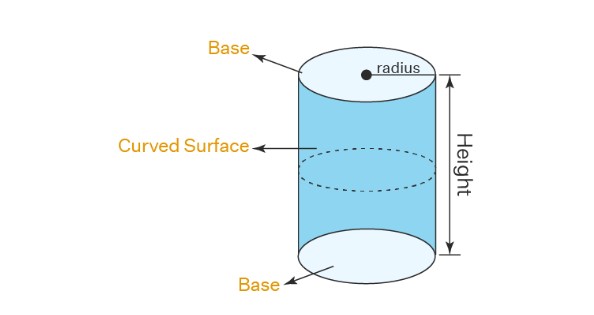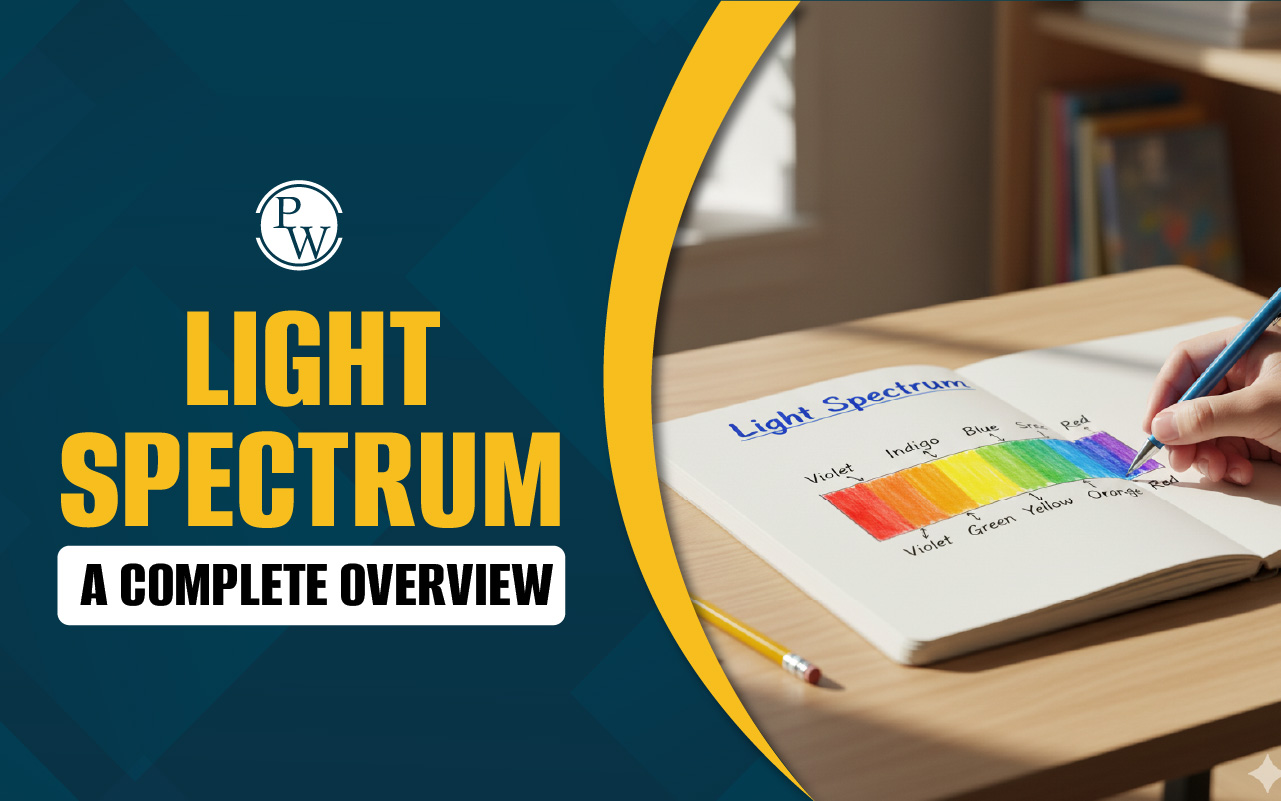
Surface Area of Cylinder: A cylinder is a three-dimensional shape with two flat circular ends and a curved side that connects them. The surface area of a cylinder is the total space covered by its outer surface.
Learning about the surface area of a cylinder is important for kids because it helps them understand basic math ideas about shapes and measurements. It also teaches them how to solve real-world problems, like figuring out how much material is needed to make objects like cans, pipes, or tanks.
This topic improves their math skills and helps them think logically and solve problems step by step. To make it easy for students, we have explained the surface area of a cylinder, its formula, types, and how to calculate it below.
Check Out - Area of Rectangle
What is Surface Area of Cylinder?
A cylinder is a 3D shape with two flat circular bases connected by a curved surface. The distance between the two bases is the cylinder's height, while the radius is the distance from the center to the edge of each circular base. It is a common shape in everyday objects like cans and pipes.
The surface area of a 3D object is the total space covered by its outer surface and is measured in square units such as square centimeters or square inches.
The surface area of a cylinder includes the area of its two circular bases and the curved surface connecting them. In simple terms, it is the total area you would cover if you were to wrap or paint the entire cylinder. Understanding the surface area helps in practical tasks, such as calculating material requirements for cylindrical objects or solving math problems.

Surface Area of Cylinder Formula
The surface area of a cylinder is calculated using formulas that measure the space covered by its curved side and its circular bases. A cylinder has two main types of surface areas:
1. Curved Surface Area (CSA): CSA of cylinder is the area of the cylindrical side that wraps around the cylinder. The formula of curved surface area of cylinder is:CSA = 2πrh
Where:- r = radius of the circular base
- h = height of the cylinder
- π (Pi) = 3.14159 (approximately)
2. Total Surface Area (TSA): TSA of cylinder includes the curved surface area and the areas of the two circular bases. The formula for the total surface area is:
TSA = 2πr(r + h)
Where:- r = radius of the circular bases
- h = height of the cylinder
- π (Pi) = 3.14159 (approximately)
Total Surface Area of Cylinder
The total surface area TSA of cylinder includes the area of its curved surface and the areas of its two circular bases. Knowing the TSA is important for practical purposes, like determining the material needed to make objects such as cans, pipes, or tanks.
Formula:
The formula to calculate the total surface area of a cylinder is: TSA = 2πr(r + h) Where:- r = radius of the circular bases
- h = height of the cylinder
- π = Pi, a constant approximately equal to 3.14159
Check Out - Area of a Circle
Parts of the Total Surface Area (TSA):
Area of the Circular Bases: A cylinder has two circular bases (top and bottom).- Area of one base = πr²
- Combined area of both bases = 2πr²
- Height = h (height of the cylinder)
- Width = 2πr (circumference of the base)
Calculation of Total Surface Area:
To calculate the total surface area, combine the area of the circular bases and the curved surface area:TSA of Cylinder = Area of bases + Curved surface area TSA = 2πr² + 2πrh TSA = 2πr(r + h)
For example, if a cylinder has a radius of 5 cm and a height of 10 cm, the total surface area can be calculated as: TSA = 2 × 3.14159 × 5 × (10 + 5) = 31.4159 × 15 ≈ 471.24 square cm.
Check Out - Area of a Sector
Curved Surface Area of Cylinder
The curved surface area (CSA) of a cylinder, also called the lateral surface area , is the area of the cylindrical sides that wrap around the cylinder. It does not include the areas of the top and bottom circular bases. Knowing the curved surface area is useful for tasks like determining how much material is needed to wrap around a cylinder without covering its bases.
The formula for calculating the curved surface area is:CSA = 2πrh
Where:- r is the radius of the circular base
- h is the height of the cylinder
- π (Pi) is approximately 3.14159
- The height of the rectangle is the same as the cylinder’s height (h).
- The width of the rectangle is the circumference of the circular base , calculated as 2πr.
The area of this rectangle (representing the curved surface area) is: Area = height × circumference = h × 2πr = 2πrh
This formula makes it easy to find the curved surface area, focusing only on the sides of the cylinder and excluding the circular bases.How to Calculate the Surface Area of Cylinder?
The surface area of a cylinder is determined by summing the areas of its two circular bases and the area of its curved surface. The following is a step-by-step guide on how to calculate it:
1. Find the area of the two bases: Each base is a circle, so use the formula for the area of a circle:Area (bases) = π × radius × radius (or πr²)
where r is the radius of the circle. Since there are two bases, multiply the area by 2:Area (bases) = 2 × πr²
2. Find the area of the curved surface (lateral surface): The curved surface can be "unfolded" into a rectangle. The height of the rectangle is the height h of the cylinder, and the width is the circumference of the base, which is 2πr. So, the lateral area is:
Area (lateral) = 2πr × h or 2πrh
3. Add the areas together: The total surface area A of the cylinder is the sum of the areas of the two bases and the lateral surface:Total Surface Area = 2πr² + 2πrh
Simplified, the formula is:Total Surface Area = 2πr(r + h)
So, to find the surface area of a cylinder, plug in the radius r and height h into this formulaDifferences Between TSA and CSA of Cylinder
The Total Surface Area (TSA) and Curved Surface Area (CSA) of a cylinder are two distinct measures related to the surface area of the cylinder.| Differences Between TSA and CSA of Cylinder | ||
| Aspect | Total Surface Area (TSA) | Curved Surface Area (CSA) |
| Definition | The total surface area of a cylinder, including both the curved surface and the two circular ends (bases). | The surface area of just the curved side (lateral surface) of the cylinder, excluding the bases. |
| Formula | TSA=2πr(h+r) | CSA = 2πrh |
| Components Included | Includes the curved surface and the two circular bases. | Includes only the curved or lateral surface. |
| Calculation Basis | Based on radius r and height h. | Based only on radius r and height h. |
| Shape Considered | Considers both the circular bases and the lateral (curved) surface. | Only the lateral (curved) surface of the cylinder. |
| Use | TSA is used when calculating the entire surface area, such as when wrapping the cylinder in material. | CSA is used when calculating the area of the lateral surface, such as when painting the curved surface. |
Key Differences:
- TSA of cylinder includes both the lateral surface and the areas of the circular bases, while CSA of cylinder includes only the lateral (curved) surface.
- TSA is greater than CSA because it accounts for more surface area (the two bases are included in TSA but not in CSA). Join Online Tuition Classes for Kids Now
| Related Articles | |
| Pie Chart | Cube |
| AM and PM | Geometry |
| Mental Maths Worksheet | Vedic Maths |
Surface Area of Cylinder FAQs
What is the surface area of a cylinder?
What is the TSA and CSA of cylinders?
What is the curved area of a cylinder?
What is TSA CSA full form?
Is a cylinder a 3D circle?









